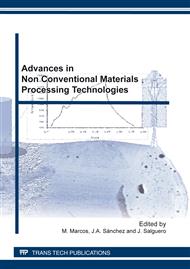p.97
p.103
p.109
p.115
p.121
p.127
p.133
p.139
p.145
Two FEM Thermal Models for Shallow and Deep Grinding
Abstract:
Grinding is a stochastic process applied in the last stages of the manufacturing cycle. In last decades, grinding research has focused on prediction of thermal damage on ground workpiece since it is of considerable importance from both research and industrial perspectives. A number of numerical and analytical thermal models have been carried out so far. However, new grinding processes such as peel grinding, creep feed grinding and others such as plongee grinding need new models which consider the effect of higher depth of cuts, but there is no information about the minimum depth of cut to consider the elimination of grounded material in FEM models. This article establishes the frontier from which the removed ground material should be physically eliminated to obtain an accurate FEM thermal model. Results show valuable information to decide which kind of model (with or without element elimination) is enough accurate for their purpose and application.
Info:
Periodical:
Pages:
145-150
Citation:
Online since:
February 2012
Authors:
Keywords:
Price:
Сopyright:
© 2012 Trans Tech Publications Ltd. All Rights Reserved
Share:
Citation:


